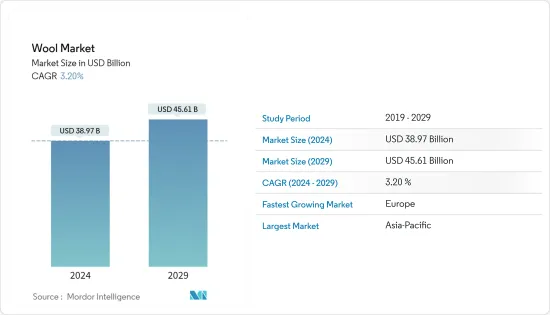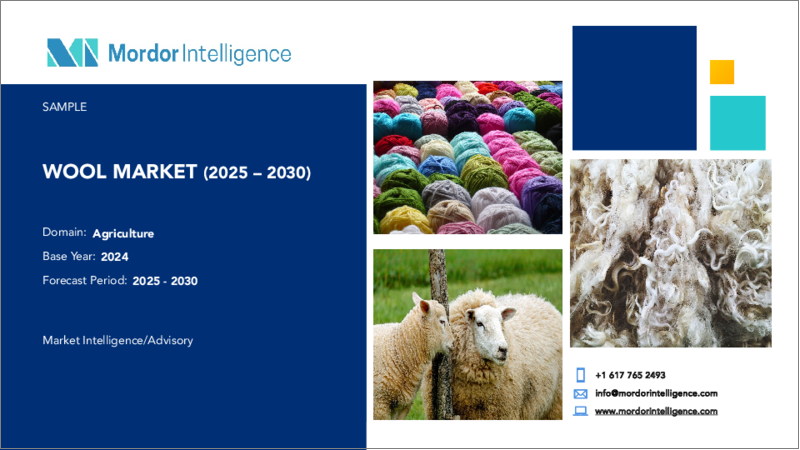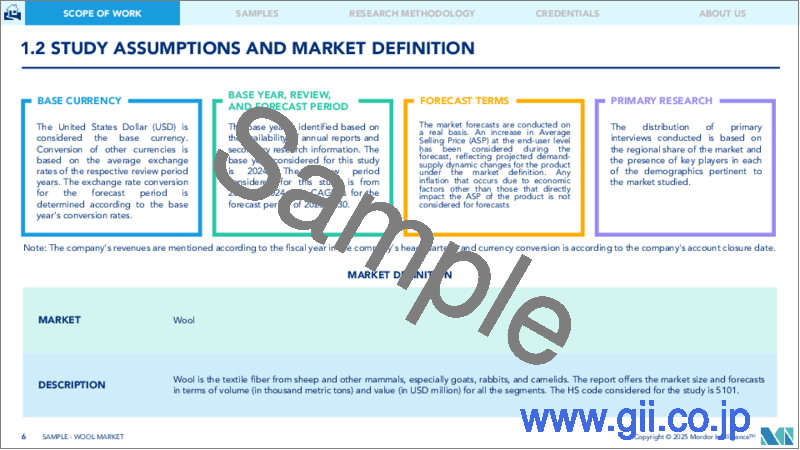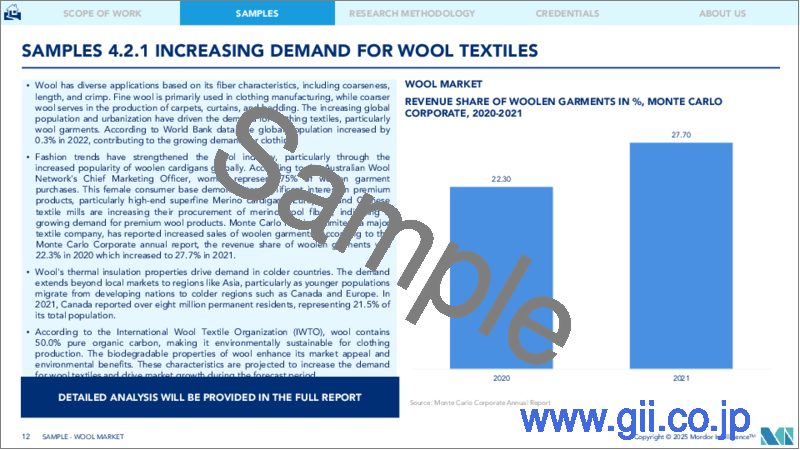|
|
市場調査レポート
商品コード
1440109
ウール:市場シェア分析、業界動向と統計、成長予測(2024~2029年)Wool - Market Share Analysis, Industry Trends & Statistics, Growth Forecasts (2024 - 2029) |
||||||
カスタマイズ可能
適宜更新あり
|
|||||||
| ウール:市場シェア分析、業界動向と統計、成長予測(2024~2029年) |
|
出版日: 2024年02月15日
発行: Mordor Intelligence
ページ情報: 英文 120 Pages
納期: 2~3営業日
|
全表示
- 概要
- 目次
ウール市場規模は2024年に389億7,000万米ドルと推定され、2029年までに456億1,000万米ドルに達すると予測されており、予測期間(2024年から2029年)中に3.20%のCAGRで成長します。

ウール製造業界の技術進歩に伴い、紡績や織りの道具が急速に発展し、世界中で衣料品の売上が増加しています。たとえば、2022年 11月に、Savioはインド市場で新しい自動巻線機Proxima Smartconerの発売を発表しました。このようなイノベーションにより、生産性の向上が期待されています。長期的に見ると、成長機会は主にミレニアル世代の消費者にあり、品質、信頼性、透明性を重視する購買行動がウール市場を牽引しています。
ウールの品質とトレーサビリティを規制する機関であるIWTOが実施したさまざまな措置により、ウールの価格が高騰し、生産が促進されています。人口の増加と都市化の進行がウール市場の成長を促進する要因です。人口の増加に伴い、ウールの衣類の需要が高まります。国際羊毛繊維機関(IWTO)によると、羊毛の重量の50.0%は純粋な有機炭素です。ウールの需要を押し上げている要因は、中国、米国、欧州などの国々での高級ウール繊維の国内消費の増加です。
さらにウールの生分解性の高さも市場を支えています。ウールは生分解性や断熱特性があり、消費者にとって適しています。これらすべての要因によりウールの需要が増加すると予想され、予測期間中に市場を牽引します。
ウール市場の動向
品質を保証する組織的な取り組みが生産を推進
WITOおよび入手可能な最新の数字によると、世界中で約12億頭の羊から約19億4,900万kg(2021年)の原毛が生産され、羊の頭数は2020年から37億頭増加しました。羊毛のサプライチェーンは長く、農場からファッションまでの道のりには多くのステップがあります。透明性と品質を確保し、ウールに関する情報の流れを促進して購入者の品質を保証するために、IWTOなどの機関は多くのトレーサビリティシステムを開発しました。そのようなシステムの1つが、National Wool Declaration Integrity Programです。 National Wool Declarationは、その透明性と農場からの追跡可能性が世界的に認められている業界の取り組みです。 NWDインテグリティプログラム(NWD-IP)は、羊毛のパイプラインを構築し、オーストラリア産羊毛に対する消費者の信頼を高めることを唯一の目的とした、机上監査と農場での検査を行う広範なプログラムです。規制当局によるこれらすべての取り組みにより、羊毛を目的とした羊の飼育も増加しているため、羊毛の価格は高騰しています。
需要による世界中の羊の頭数の増加も成長を支えています。中国は世界の羊飼育のリーダーです。 FAOによると、中国の羊の頭数は2019年の1億6,349万頭から2020年の1億7,301万頭まで増加しました。したがって、羊の頭数の増加と品質確保のための制度的取り組みにより、予測期間中の羊毛の生産が促進されると予想されます。
アジア太平洋が市場を独占
ウールは世界中で取引される商品であり、市場におけるウールの多様性は膨大であり、常に進化しています。ほとんどのウールはIWTOテスト証明書付きで販売されているため、品質に対する購入者の自信が保証されています。アジア太平洋地域は生産量と輸出量が多く、ウール市場を独占しています。 FAOSTATによると、オーストラリア、中国、ニュージーランドが羊毛の主要生産国です。 ITC Tradeによると、2020年にオーストラリアが15億9,532万米ドル相当の輸出を占め、次いで中国が15億4,386万8,000米ドル相当を占め、輸出総額の36.2%を占めました。
インドは毛糸生地、手作りカーペット、既製衣料品をイタリア、韓国、英国、米国、スリランカ、ドイツ、オーストラリア、アラブ首長国連邦、スウェーデン、オランダ、オマーン、アフガニスタン、そしてタンザニアなど。米国はインドからのウール製品の主要輸入国であり、2020年から2021年の輸出額は8億5,560万米ドルに達しました。毛織物は主にイタリア、韓国、英国、米国、スリランカ、ドイツ、オーストラリアに輸出されています。 2020年から2021年にかけて、これらの国はインドから513.9カロールインドルピー(6,450万米ドル)相当の糸織物を輸入し、糸の総輸出量の64%を占めました。同時期の主要輸入国はイタリアで17.5%でした。
国連コムトレードによると、2021年にオーストラリアから中国に輸出された羊毛の貿易額は約19億米ドルに達しました。これは、その年にオーストラリアから輸出された羊毛の最高貿易額でした。オーストラリアは世界有数の羊毛供給国であり、世界の羊毛輸出量の39%を占める世界最大の羊毛輸出国です。オーストラリアではファインメリノの生産が優勢であるため、オーストラリア産ウールは通常、高級ファッションや軽量ニットウェアとして小売られています。アジア太平洋地域のアパレル業界では、環境に優しく、持続可能で、生分解性を重視する傾向があり、快適さを提供するウールの需要が高まっています。したがって、市場は明らかにこの地域のミレニアル世代とZ世代によって動かされています。
その他の特典
- エクセル形式の市場予測(ME)シート
- 3か月のアナリストサポート
目次
第1章 イントロダクション
- 調査の前提条件と市場の定義
- 調査範囲
第2章 調査手法
第3章 エグゼクティブサマリー
第4章 市場力学
- 市場概要
- 市場促進要因
- 市場抑制要因
- バリューチェーン分析
第5章 市場セグメンテーション
- 地域(生産分析、金額と数量による消費分析、金額と数量による輸入分析、金額と数量による輸出分析、価格動向分析)
- 米国
- メキシコ
- ドイツ
- ベルギー
- 英国
- オランダ
- トルコ
- 中国
- オーストラリア
- ニュージーランド
- モロッコ
第6章 市場機会と将来の動向
The Wool Market size is estimated at USD 38.97 billion in 2024, and is expected to reach USD 45.61 billion by 2029, growing at a CAGR of 3.20% during the forecast period (2024-2029).

With the technological advancements in the wool manufacturing industry, there is a rapid development of spinning and weaving tools leading to increased sales of clothing across the globe. For instance, in November 2022, Savio announced the launch of an automatic new winding machine Proxima Smartconer in the Indian market. Such innovations are expected to increase productivity. Over the long term, growth opportunities mainly lie with millennial consumers whose purchasing behavior, such as the preference for quality, authenticity, and transparency, is driving the market for wool.
Various measures undertaken by the IWTO, a regulating authority for wool quality and traceability, are fetching higher prices for wool, thus encouraging production. Growing population and rising urbanization are the factors boosting the growth of the wool market. As the population increases, the demand for wool clothing rises. According to International Wool Textile Organization (IWTO), 50.0% weight of the wool is pure organic carbon. The factor driving wool demand is the increasing domestic consumption of luxury wool textiles in countries such as China, the United States, and Europe.
Moreover, the biodegradable quality of wool is also supporting the market. Wool is a natural decomposer since it is biodegradable and provides less harm to the environment. In addition, wool consists of thermal insulation properties making it suitable for consumers. All these factors are expected to increase the demand for wool, thus driving the market during the forecast period.
Wool Market Trends
Institutional Initiatives Ensuring the Quality is Driving the Production
According to WITO and the most recent available figures, around 1,949 million kg (2021) of raw wool was produced by around 1.2 billion sheep around the world, and the sheep population rose by 3.7 billion from 2020. The wool supply chain is long, with many steps en route from farm to fashion. To ensure transparency and quality and to facilitate the flow of information about wool to assure buyers of the qualities being purchased, institutions like IWTO have developed many traceability systems. One such system is the National Wool Declaration Integrity Program. The National Wool Declaration is an industry initiative recognized globally for its transparency and traceability from the farm. The NWD Integrity Program (NWD-IP) is an extensive program of Desktop Audits and On-Farm Inspections with the single purpose of building a wool pipeline and consumer confidence in Australian wool. With all these initiatives put forth by the regulating authority, wool is fetching a higher price because sheep rearing for wool is also increasing.
The increase in the sheep population across the globe owing to the demand is also supporting the growth. China is the leader in terms of sheep rearing globally. According to FAO, the sheep population in China increased from 163.49 million in 2019 to 173.01 million in 2020. Thus, the increasing sheep population and the institutional initiatives for ensuring quality are expected to drive wool production during the forecast period.
Asia-Pacific Dominates the Market
Wool is a commodity traded globally, and its diversity in the market is vast and ever-evolving. With most of the wool sold with an IWTO Test Certificate, the buyer's confidence in quality is guaranteed. The Asia-Pacific region is dominating the wool market with high production and exports. According to FAOSTAT, Australia, China, and New Zealand are the major producers of wool. According to ITC Trade, in 2020, Australia accounted for the highest exports worth USD 1,595,320 thousand, followed by China, accounting for exports worth USD 1,543,868 thousand in 2020, contributing 36.2% of the total export.
India exports woolen yarn fabrics, hand-made carpets, and ready-made garments to Italy, Korea, the United Kingdom, the United States, Sri Lanka, Germany, Australia, the United Arab Emirates, Sweden, the Netherlands, Oman, Afghanistan, and Tanzania, among others. The United States is a major importer of woolen products from India, with exports valued at USD 855.6 million in 2020-21. Woolen fabrics are mainly exported to Italy, Korea, the United Kingdom, the United States, Sri Lanka, Germany, and Australia. During 2020-21, these countries imported INR 513.9 crore (USD 64.5 million) worth of yarn fabrics from India, representing a share of 64% of the total yarn exports. Italy was the major importer during the same period at 17.5%.
According to UN Comtrade, in 2021, the trade value of wool exported from Australia to China amounted to about USD 1.9 billion. This was the highest trade value of wool exported from Australia that year. Australia is the leading global supplier of wool and the world's largest wool export nation, accounting for 39% of global wool exports. Given the dominance of fine Merino production in Australia, Australian wool is typically retailed as high-end fashion and lightweight knitwear. With the trend toward eco-friendly, sustainable, and biodegradable parameters in the Asia-Pacific apparel industry, the demand for wool is growing as it provides comfort. Thus, the market is driven explicitly by the millennial and Gen Z population in the region.
Additional Benefits:
- The market estimate (ME) sheet in Excel format
- 3 months of analyst support
TABLE OF CONTENTS
1 INTRODUCTION
- 1.1 Study Assumptions and Market Definition
- 1.2 Scope of the Study
2 RESEARCH METHODOLOGY
3 EXECUTIVE SUMMARY
4 MARKET DYNAMICS
- 4.1 Market Overview
- 4.2 Market Drivers
- 4.3 Market Restraints
- 4.4 Value Chain Analysis
5 MARKET SEGMENTATION
- 5.1 Geography (Production Analysis, Consumption Analysis by Value and Volume, Import Analysis by Value and Volume, Export Analysis by Value and Volume, and Price Trend Analysis)
- 5.1.1 United States
- 5.1.2 Mexico
- 5.1.3 Germany
- 5.1.4 Belgium
- 5.1.5 United Kingdom
- 5.1.6 Netherlands
- 5.1.7 Turkey
- 5.1.8 China
- 5.1.9 Australia
- 5.1.10 New Zealand
- 5.1.11 Morocco





